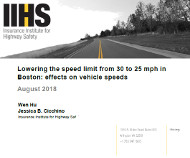9/6/2018
IIHS Fakes Speed Limit Study ResultsIIHS study proves average speeds unchanged despite lowering speed limit. Press release implied the exact opposite result.

The Insurance Institute for Highway Safety (IIHS) boldly proclaimed last week last week that its new study proved lowering speed limits reduced speeding. The report examined the effect of the speed limit reduction that took effect in Boston, Massachusetts, in January 2017. The National Motorists Association (NMA), a drivers' advocacy group, says the IIHS is intentionally misleading the public.
"Lowering the speed limit by 5 MPH on city streets can improve safety for motorists, pedestrians and bicyclists alike by reducing speeding, new research by the Insurance Institute for Highway Safety indicates," the insurance industry press release claimed.
The study, which did not consider any safety-related data, found no change in the mean speeds of traffic after the speed limit was lowered. Because the speed limit was lowered, however, "speeding" increased to 47 percent of traffic, compared to just 18 percent before the change in speed limit.
IIHS researchers produced the figures after gathering off-peak speed data from October through December 2016 to serve as "before" data. This was compared with data from September through November 2017, the "after" period. In Boston, the mean speed of traffic when the speed limit signs read 30 MPH was 24.8 MPH. After Boston installed 25 MPH signs, mean speeds remained 24.8 MPH. Likewise, the 85th percentile speed (the speed that the vast majority, 85 percent were traveling), remained 31 MPH. Mean speeds increased by just 0.1 MPH in the "after" period in Providence, Rhode Island, that IIHS used as a control group because the speed limits did not change in that city.
"Average and 85th percentile speeds did not change meaningfully," the study's authors admitted.
Rather than stop there, the authors created a statistical model to estimate an "expected" change in speeds. This calculation was used to transform a one percent reduction in the number of drivers exceeding 35 MPH in the after period into the "22 percent" reduction touted in the IIHS press release. The NMA contends that this statistical manipulation is inherently dishonest.
"The hard data showed mean speeds and 85th percentile speeds stayed exactly the same," said NMA Foundation executive director James C. Walker told TheNewspaper. "Only IIHS could take those facts and claim that anything meaningful happened relative to safety or anything else."
IIHS, the public relations arm of the insurance industry, has a direct financial interest in coming to a conclusion that favors lowered speed limits. The group has been lobbying to eliminate the 85th percentile rule, which states like California and Michigan must use by law when setting speed limits.
"Michigan uses this methodology because it is the national standard for setting speed limits, recognizing that the great majority of drivers instinctively drive at a speed that is safe and comfortable based on the roadway design and other factors," the state Department of Transportation explained. "This also results in fewer conflicts between drivers, which lead to unsafe actions such as tailgating and improper passing."
The IIHS study showed that, although speeds did not change, more people would find themselves in violation of the law under the lowered limit. IIHS member companies earn millions from surcharges each time a traffic ticket is issued.
A copy of the IIHS report is available in a 250k PDF file at the source link below.


